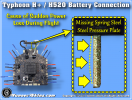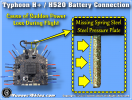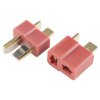The connection of the battery to the main board is a Dean's Pin type (see below), and has been/is a standard throughout the industry. If that pic above is from your main board it would indeed indicate a problem. If Yuneec has copied this connection (and there is no reason to think they haven't) then perhaps there is a flaw in some of these items.
I would point out a couple things: 1] All Typhoons use these same connections for the aircraft-to-battery, though the cell connections for all Typhoon batteries are different, 2] In the past, power failures mid flight - (particularly with the 480) - seemed to indicate the battery was not fully seated, and 3] The New H3 has a tiny switch that can detect (and alert) when a battery is not properly/fully inserted.
What I am getting at is: In the past, most power failures have almost certainly been from an improperly inserted battery, we know this, and Yuneec's installation of a battery position switch in the H3 confirms this. Also, while the Deans type connector has been used in millions of applications, I can also see that perhaps Yuneec's version of it could have flaws and this could be a case of such a failure.
My point here is to not dismiss either as a potential.
@Swashplate if you post your telemetry I will take a look.
View attachment 25356








